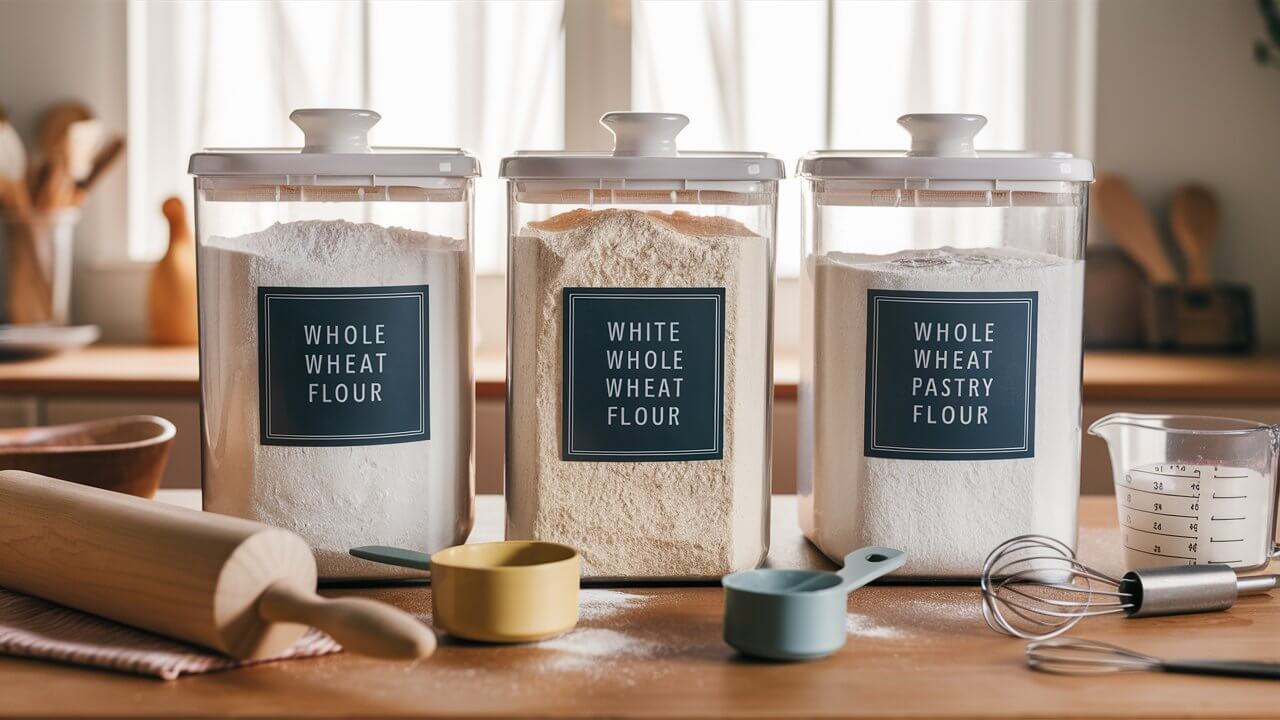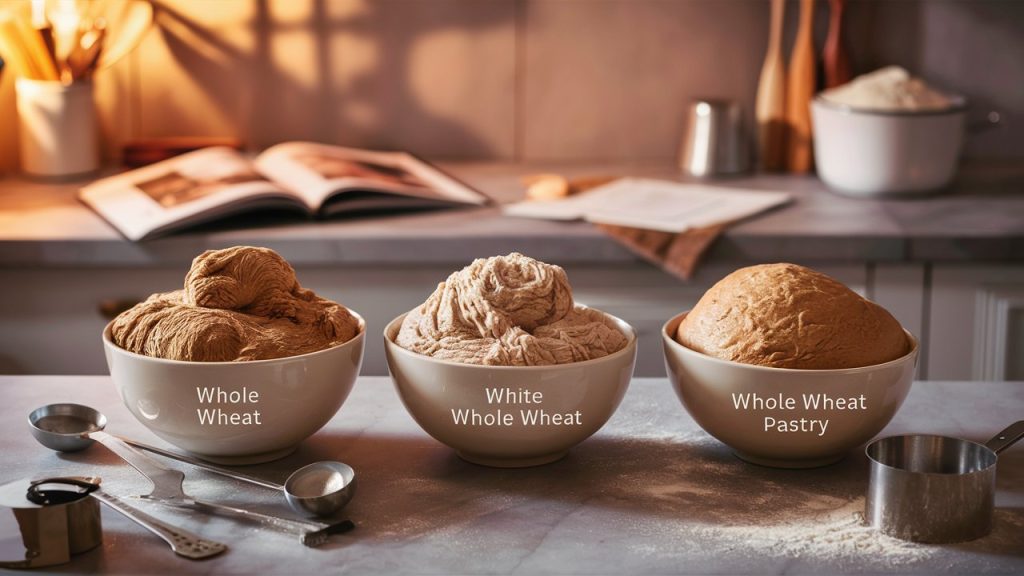
In cooking and baking, the kind of flour you use is crucial. Given the abundance of choices, one may easily become perplexed about which flour would be most appropriate for their requirements. Particularly for those looking for better substitutes, whole wheat flour, white whole wheat flour, and whole wheat pastry flour are among the most often used among the several kinds. This page will explore the variations among various flours, thereby guiding your cooking decisions.
Table of Contents
Understanding Whole Wheat Flour
Grinding the whole wheat kernel—that which comprises the bran, germ, and endosperm—makes whole wheat flour Consequently, it is a better option than refined flours since it preserves all the nutrients, including minerals, vitamins, and fiber. Whole wheat flour gets its distinctive dark hue and somewhat nutty taste from including the bran and germ.
Whole Wheat Flour’s Nutritional Superiorities
- Whole wheat flour loads in vital nutrients:
- Fiber : Aids in gut maintenance and digestion.
- Vitamins high in B vitamins, which are absolutely vital for brain function and energy generation.
- Comprising iron, magnesium, and zinc,
- Minerals: assist several body processes.
Uses of Whole Wheat Flour
Whole wheat flour is versatile and can be used in a variety of recipes, including:
- Bread
- Pancakes
- Muffins
- Cookies
- pizza dough
It is therefore usually mixed with other flours in baking since its denser texture and greater flavour could influence the taste and texture of the finished product.
White Whole Wheat Flour.
Though it’s derived from a distinct variety of wheat called hard white wheat, White whole wheat flour is a sort of whole wheat flour. White whole wheat flour appeals more to individuals who find ordinary whole wheat flour too strong since it has a lighter color and gentler flavor than conventional whole wheat flour, which is derived from hard red wheat.
Comparative Nutritional Analysis: Whole Wheat Flour Vs White Whole Wheat Flour
White whole wheat flour is essentially just like whole wheat flour nutritionally. Maintaining the bran, germ, and endosperm, it guarantees the same health advantages:
Fiber: Helping digestion, same as whole wheat flour.
Vitamins : Has B vitamins necessary for general health.
Minerals: abound in iron, magnesium, and zinc.
Uses of White Whole Wheat Flour
White whole wheat flour is sometimes favored in recipes calling for a softer taste and texture since it is lighter in color and milder in flavor:
- Sandwich
- bread
- Pastries
- cakes
- biscuits.
Many recipes call for white whole wheat flour as a straight substitution for all-purpose flour, providing a better choice without sacrificing taste.
Exploring Whole Wheat Pastry Flour
Made from soft wheat, whole wheat pastry flour is a finely milled flour. Made from soft wheat, it has less protein than whole wheat flour, even though it has a full wheat kernel. For delicate baked items, this results in a lighter consistency and better texture.
Whole Wheat Pastry Flour Nutritional Profile
Though it has a somewhat different composition, whole wheat pastry flour has nutritional value comparable to that of ordinary whole wheat flour.
Though somewhat less than whole wheat flour:
- Fiber still offers a reasonable level.
- Vitamins: Provides B vitamins, therefore enhancing general well-being and energy levels.
- Minerals: Included among the vital minerals are iron and magnesium.
Purposes for Whole Wheat Pastry Flour
Recipes calling for a soft and light texture will find whole wheat pastry flour ideal.
- Pastries
- Cakes
- Pie crusts
- Cookies
Whole wheat pastry flour is a favorite among pastry chefs because of its reduced protein level; it makes lighter and more delicate baked products.
Key Differences Between Whole Wheat Flour, White Whole Wheat Flour, and Whole Wheat Pastry Flour
Knowing the main variations between these three kind of flour will enable you to select the correct one for your particular baking requirements.
| Feature | Whole Wheat Flour | White Whole Wheat Flour | Whole Wheat Pastry Flour |
| Wheat Type | Hard Red Wheat | Hard White Wheat | Soft Wheat |
| Color | Brown | Light Brown | Light Brown |
| Flavor | Nutty, Robust | Mild, Slightly Sweet | Mild, Delicate |
| Texture | Coarse, Dense | Finer, Slightly Less Dense | Fine, Light |
| Protein Content | High | High | Low |
| Best Used For | Bread, Pancakes, Muffins | Sandwich Bread, Cakes | Pastries, Pie Crusts |
Choosing the Correct Flour for Your Purposes
The kind of recipe you are cooking and your own tastes will determine the correct flour to use.
For Breads and Hearty Baked Goods:
Whole wheat flour is a great substitute for bread, muffins, or pancakes you are making. For substantial baked products, its strong taste and thick texture fit quite well.
For Everyday Baking:
White whole wheat flour is perfect if you want a milder taste but still wish for the nutritious value of whole wheat. From cakes to cookies, it’s flexible enough to be applied in a great variety of dishes.
For Delicate Pastries
Whole wheat pastry flour is the best choice when creating pie crusts, other delicate baked products, or pastries. Its less protein guarantees a soft and flaky feel.
Tips for Baking with Whole Wheat Flour, White Whole Wheat Flour, and Whole Wheat Pastry Flour
Using these flours will help you produce the greatest outcomes; here are some pointers to guide you:

- Combine with All-Purpose Flour: Start by combining whole wheat flour or white whole wheat flour with all-purpose flour if you are new to using either. Without radically altering your recipe, this will let you grow used to the texture and taste.
- Increase Hydration: Whole wheat flours absorb more moisture than all-purpose flour, hence you might have to change the liquid quantity in your recipes to get the intended consistency.
- Use White Whole Wheat Flour for a Milder Taste: If you or your family find the strong taste of traditional whole wheat flour objectionable, white whole wheat flour can be a terrific substitute that still provides the nutritious value.
- Experiment with Whole Wheat Pastry Flour:: Made for smaller baked products, whole wheat pastry flour is superb. Use it without hesitate in recipes calling for a delicate touch.
- Rest the Dough: Using whole wheat flour will help the dough to rest for around 10 to 15 minutes before baking, therefore enhancing its texture.
Frequently Asked Questions (FAQs)
Q: Can I substitute whole wheat flour for white whole wheat flour in recipes?
A: Yes, you can substitute whole wheat flour for white whole wheat flour in most recipes. However, keep in mind that whole wheat flour has a stronger flavor and a denser texture.
Q: Is whole wheat pastry flour healthier than regular whole wheat flour?
A: Whole wheat pastry flour and regular whole wheat flour have similar nutritional profiles. However, whole wheat pastry flour is lower in protein, making it better suited for lighter, more delicate baked goods.
Q: Can I use whole wheat flour in cakes and pastries?
A: While you can use whole wheat flour in cakes and pastries, it may result in a denser texture. For a lighter outcome, consider using whole wheat pastry flour or white whole wheat flour.
Q: Does white whole wheat flour contain less fiber than whole wheat flour?
A: No, white whole wheat flour contains the same amount of fiber as regular whole wheat flour. The main difference lies in the flavor and texture.
Q: How should I store whole wheat flours?
A: Whole wheat flours should be stored in an airtight container in a cool, dark place. For longer shelf life, consider refrigerating or freezing them.
Q: Can I use whole wheat pastry flour for bread baking?
A: Whole wheat pastry flour is not ideal for bread baking due to its lower protein content. It’s best used for pastries, cookies, and other light baked goods.
In conclusion
Your baking outcomes can be much improved by knowing the variations among whole wheat flour, white whole wheat flour, and whole wheat pastry flour. Every kind of flour has certain qualities that fit particular recipes. Choosing the correct flour can help your baked products come out just the way you want them, whether your goal is a delicate pastry, a filling loaf of bread, or something in between. Following the advice given and experimenting with various flours will help you to enjoy the nutritional value of whole grains while producing wonderful and filling sweets.



